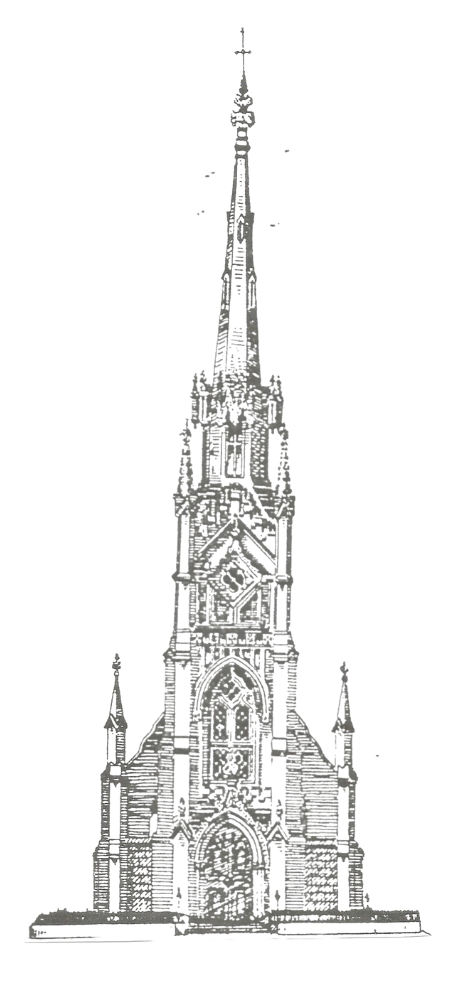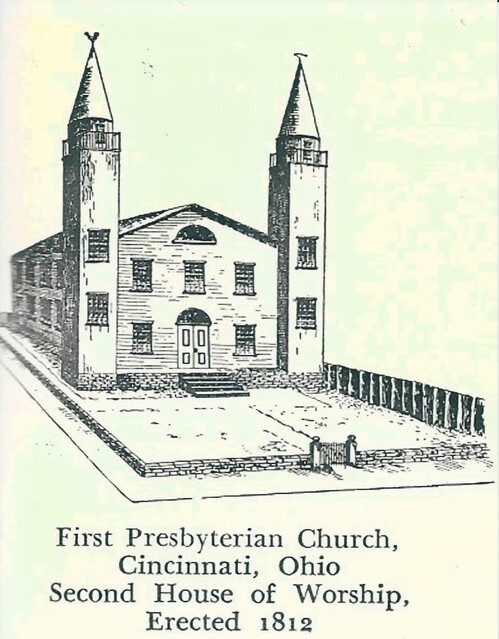About Us
About historic Covenant-First Presbyterian Church and Cincinnati
A bit of early Cincinnati History
Our historic houses of worship
The history of Covenant-First Presbyterian Church is coextensive with much of the history of Cincinnati itself and therefore a brief historical review of the Queen City is both appropriate and enlightening.
Only two years older than our church, the community that became the City of Cincinnati was founded by European Americans in 1788 on the north bank of the Ohio River at the confluence of the Licking River. It was originally named “Losantiville,” but the name was changed in 1790 in honor of the Society of Cincinnati, a group of Revolutionary War veterans of which George Washington was the first president. The group was named after Lucius Quinctius Cincinnatus (519–430 BC), a Roman statesman who was regarded as a model of virtue and simplicity.
In 1788, southern Ohio was little more than a wilderness. Fort Washington, a fortified settlement consisting of blockhouses, was built to provide adequate defense against the scores of attacks from the Native Americans — primarily of the Miami Tribe — living in the area. In 1791, President Washington ordered General Arthur St. Clair, the governor of the Northwest Territory, to march north from Fort Washington to suppress the “Indian menace.” In a fierce battle north of Cincinnati, St. Clair’s forces sustained three times the number of casualties suffered by the forces of Gen. George Armstrong Custer in his “last stand” at the Battle of the Little Bighorn.
The Indian attacks caused widespread panic across the territory, but James Kemper, the first pastor of the fledgling Presbyterian church, encouraged the citizens not to give up. One witness stated that the Reverend Kemper and his little Presbyterian church were all that prevented the settlers from abandoning the settlement for the safer south shore of the Ohio River. In 1793, the forces of General “Mad” Anthony Wayne were victorious at the Battle of Fallen Timbers, and the 1795 Treaty of Greenville ended the Indian wars and brought peace to Ohio.
Today, Cincinnati continues to be among the leading commercial cities in the country. Nine Fortune 500 companies and fifteen Fortune 1000 companies have headquarters in the Cincinnati area, ranking it in the Top 10 markets for number of Fortune 500 headquarters per million residents, higher than New York, Boston, Chicago, or Los Angeles.
Cincinnati is the third-largest city in Ohio and the 65th-largest city in the United States, with just over 300,000 people living in the city limits of Cincinnati proper. The population of the Greater Cincinnati metropolitan area, however, is over 2.2 million, the 28th-largest Metropolitan Statistical Area in the United States and the largest in Ohio.
Only two years older than our church, the community that became the City of Cincinnati was founded by European Americans in 1788 on the north bank of the Ohio River at the confluence of the Licking River. It was originally named “Losantiville,” but the name was changed in 1790 in honor of the Society of Cincinnati, a group of Revolutionary War veterans of which George Washington was the first president. The group was named after Lucius Quinctius Cincinnatus (519–430 BC), a Roman statesman who was regarded as a model of virtue and simplicity.
In 1788, southern Ohio was little more than a wilderness. Fort Washington, a fortified settlement consisting of blockhouses, was built to provide adequate defense against the scores of attacks from the Native Americans — primarily of the Miami Tribe — living in the area. In 1791, President Washington ordered General Arthur St. Clair, the governor of the Northwest Territory, to march north from Fort Washington to suppress the “Indian menace.” In a fierce battle north of Cincinnati, St. Clair’s forces sustained three times the number of casualties suffered by the forces of Gen. George Armstrong Custer in his “last stand” at the Battle of the Little Bighorn.
The Indian attacks caused widespread panic across the territory, but James Kemper, the first pastor of the fledgling Presbyterian church, encouraged the citizens not to give up. One witness stated that the Reverend Kemper and his little Presbyterian church were all that prevented the settlers from abandoning the settlement for the safer south shore of the Ohio River. In 1793, the forces of General “Mad” Anthony Wayne were victorious at the Battle of Fallen Timbers, and the 1795 Treaty of Greenville ended the Indian wars and brought peace to Ohio.
Today, Cincinnati continues to be among the leading commercial cities in the country. Nine Fortune 500 companies and fifteen Fortune 1000 companies have headquarters in the Cincinnati area, ranking it in the Top 10 markets for number of Fortune 500 headquarters per million residents, higher than New York, Boston, Chicago, or Los Angeles.
Cincinnati is the third-largest city in Ohio and the 65th-largest city in the United States, with just over 300,000 people living in the city limits of Cincinnati proper. The population of the Greater Cincinnati metropolitan area, however, is over 2.2 million, the 28th-largest Metropolitan Statistical Area in the United States and the largest in Ohio.

In January 1789, surveyor Israel Ludlow laid out plans for the community that was to become Cincinnati, including a public area between Fourth, Fifth, Walnut, and Main streets to include a Presbyterian church. The seeds of what was to become Covenant-First Presbyterian Church were sown on October 16, 1790, when the First Presbyterian Church was organized on the west side of Main Street just north of Fourth Street. Today, a memorial plaque honoring Israel Ludlow is prominently featured in the courtyard of our church.
To build the first church, subscriptions were taken from every male resident. Rev. James Kemper committed five dollars, five days’ of his work, five days’ of work by his oxen team, and five boat planks. The 30' x 40' frame building was the first Presbyterian church in the Northwest Territory. As the direct descendant of that early church, Covenant-First is the oldest Presbyterian congregation west of the Allegheny Mountains.
According to Judge Jacob Burnet, the church “was enclosed with clapboards, but neither lathed, plastered or ceiled. The floor was made of boat-plank, laid loosely on sleepers. The seats were constructed of the same material, supported by blocks of wood. They were, of course, without backs; and here our forefather pioneers worshiped, with their trusty rifles between their knees.” (For safety, church members were required to carry their rifles to fend off potential Indian attacks and were fined if they failed to do so.) There was no pulpit, and Rev. Kemper often delivered sermons while standing on a barrel.
Its formal name was First Presbyterian Church, but because it was the first church organized in the settlement, it became known simply as “First Church.” Within a few years, the congregation had grown and challenged the capacity of the original building. To accommodate such growth, the church conducted a building campaign, raising over $16,000 from such distinguished Cincinnati icons as Judge Burnet, Martin Baum, William Lytle, and Nicholas Longworth. The new structure, which replaced Kemper’s original primitive building, was completed in 1815, featured two square towers with conical turrets, and the building was informally called “the two-horned church.”
To build the first church, subscriptions were taken from every male resident. Rev. James Kemper committed five dollars, five days’ of his work, five days’ of work by his oxen team, and five boat planks. The 30' x 40' frame building was the first Presbyterian church in the Northwest Territory. As the direct descendant of that early church, Covenant-First is the oldest Presbyterian congregation west of the Allegheny Mountains.
According to Judge Jacob Burnet, the church “was enclosed with clapboards, but neither lathed, plastered or ceiled. The floor was made of boat-plank, laid loosely on sleepers. The seats were constructed of the same material, supported by blocks of wood. They were, of course, without backs; and here our forefather pioneers worshiped, with their trusty rifles between their knees.” (For safety, church members were required to carry their rifles to fend off potential Indian attacks and were fined if they failed to do so.) There was no pulpit, and Rev. Kemper often delivered sermons while standing on a barrel.
Its formal name was First Presbyterian Church, but because it was the first church organized in the settlement, it became known simply as “First Church.” Within a few years, the congregation had grown and challenged the capacity of the original building. To accommodate such growth, the church conducted a building campaign, raising over $16,000 from such distinguished Cincinnati icons as Judge Burnet, Martin Baum, William Lytle, and Nicholas Longworth. The new structure, which replaced Kemper’s original primitive building, was completed in 1815, featured two square towers with conical turrets, and the building was informally called “the two-horned church.”

As the congregation continued to grow, an independent group branched off and in 1830 built the Second Presbyterian Church, a Grecian-styled church on the south side of Fourth Street between Vine and Race (later the site of McAlpin’s Department Store). This structure can be seen clearly in the Cincinnati Daguerreotype on display at the Cincinnati Public Library.
In 1851, First Presbyterian built an elegant new church on Fourth Street near the location of Kemper’s first church and the subsequent two-horned church. The Gothic-styled church and its 285-foot neo-Gothic spire topped with a golden hand pointing heavenward was declared “the finest west of the Alleghenies.”
In the 1870s, Second Presbyterian selected a serene rustic location at Eighth and Elm Streets — outside the hustle and bustle of the financial district — for the site of its new church. The land was purchased and the present structure erected at a cost of $250,000. The magnificent building was dedicated on April 11, 1875, and, through a series of mergers, it eventually became the home of Covenant-First Presbyterian Church.
In 1851, First Presbyterian built an elegant new church on Fourth Street near the location of Kemper’s first church and the subsequent two-horned church. The Gothic-styled church and its 285-foot neo-Gothic spire topped with a golden hand pointing heavenward was declared “the finest west of the Alleghenies.”
In the 1870s, Second Presbyterian selected a serene rustic location at Eighth and Elm Streets — outside the hustle and bustle of the financial district — for the site of its new church. The land was purchased and the present structure erected at a cost of $250,000. The magnificent building was dedicated on April 11, 1875, and, through a series of mergers, it eventually became the home of Covenant-First Presbyterian Church.
